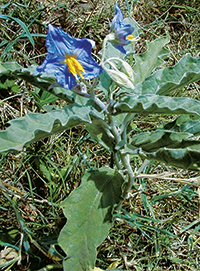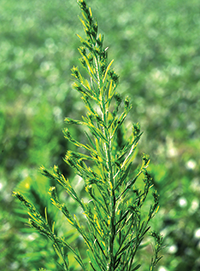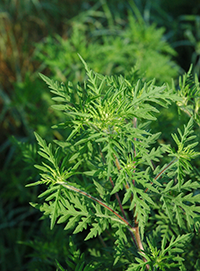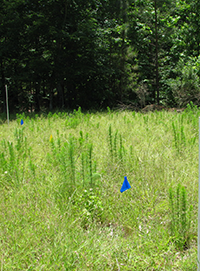Connect with Range & Pasture:
The Nightmare Weeds of 2025

If weedy worries are keeping you awake at night, we have good news. First, you’re not alone. Based on the survey results of Corteva Agriscience Range & Pasture Specialists, ranchers across the country are fighting many of the same problems. Second, Corteva has a solution for just about any weeds that may be causing you grief. Ready to get back to sleep? Find the solution to your nightmare weeds below.
About: One of the more aggravating weed families, thistles come in a variety of species. Of the four main types that cause the most concern for U.S. growers and ranchers, musk, bull and Scotch thistles are all biennials, while Canada thistle is a hardy perennial. Thistles can be easily identified by the spiny leaves and round, purple or pink flowers that resemble pincushions. Not only do these prickly pests compete with forage grasses for moisture and nutrients but also they, in effect, shrink pastures because cattle avoid grazing near them.
Treatment: For biennial thistles, apply NovaGraz at 24 fluid ounces per acre plus 1% MSO v/v. For bull and musk thistle, apply 12 to 16 fluid ounces of DuraCor® herbicide per acre or 1¼ pints per acre of GrazonPD3™ herbicide at the rosette stage, or apply 2 to 2⅔ pints per acre of GrazonPD3 from bolting to bud stage. For Scotch thistle, apply 16 to 20 fluid ounces of DuraCor per acre or 1 ¼ pints per acre of GrazonPD3 at the rosette stage, or 2 to 2⅔ pints per acre of GrazonPD3 from bolting to bud stage. For Canada thistle, apply 16 to 20 fluid ounces of DuraCor per acre or 2½ pints per acre of GrazonPD3 prior to bud stage.
 About: Silverleaf nightshade has foliage with a gray or silvery appearance with violet, light blue or white flowers and is 1 to 3 feet tall. Stems are sparsely covered with short, yellow thorns. Leaves and stems have a dense silvery covering of hair.
About: Silverleaf nightshade has foliage with a gray or silvery appearance with violet, light blue or white flowers and is 1 to 3 feet tall. Stems are sparsely covered with short, yellow thorns. Leaves and stems have a dense silvery covering of hair.
Treatment: Apply 12 to 16 fluid ounces of DuraCor herbicide per acre or 1¼ pint per acre of GrazonPD3 herbicide when plants are 4 to 6 inches tall, or 2 to 2⅓ pints per acre of GrazonPD3 when flowering or for longer residual control of later-emerging plants. Re-treatment is necessary for total control.
 About: Horseweed, also known as marestail, is a tall-growing winter or summer annual. Its stem usually has short bristly white hairs with many alternate and lance-shaped leaves. It blooms June to August with numerous tiny, inconspicuous flowers.
About: Horseweed, also known as marestail, is a tall-growing winter or summer annual. Its stem usually has short bristly white hairs with many alternate and lance-shaped leaves. It blooms June to August with numerous tiny, inconspicuous flowers.
Treatment: Apply 24 fluid ounces per acre of NovaGraz plus 1% MSO v/v, or 12 to 16 fluid ounces of DuraCor® herbicide per acre, or ⅔ to 1¼ pints per acre of GrazonPD3 herbicide when weeds are less than 3 inches tall, or 2 to 2⅔ pints per acre of GrazonPD3 when plants are taller than 3 inches through early flowering stage.
About: While woolly croton may be desirable as habitat for certain game birds, it’s less valuable as forage. Woolly croton can be identified by the staggered leaves set along a longer stem; leaves are narrow and pointed, with no lobes.
Treatment: Apply 16 to 20 fluid ounces of DuraCor herbicide or ⅔ to 1¼ pints per acre of GrazonPD3 herbicide when weeds are less than 3 inches tall, or 2 to 2⅔ pints per acre of GrazonPD3™ when plants are taller than 3 inches tall through early flowering stage.
 About: Western ragweed can be found throughout much of the United States but is particularly prevalent in the Southwest. Western ragweed grows into a bushy plant, 1 to 2 feet tall, with silvery-green leaves that may be covered with fine hairs. This drought-hardy weed is a prolific reproducer, so multiple treatments may be necessary for complete control.
About: Western ragweed can be found throughout much of the United States but is particularly prevalent in the Southwest. Western ragweed grows into a bushy plant, 1 to 2 feet tall, with silvery-green leaves that may be covered with fine hairs. This drought-hardy weed is a prolific reproducer, so multiple treatments may be necessary for complete control.
Treatment: Apply 24 fluid ounces per acre of NovaGraz plus 1% MSO v/v, or 16 to 20 fluid ounces per acre of DuraCor herbicide, or 5 pints of GrazonPD3 herbicide per acre per 100 gallons of spray. For best control, apply to weeds that are actively growing but prior to flowering.
 About: Carolina and western horsenettle have erect stems, loosely branched and covered with gray hairs, and yellow spines. The weeds grow to 2 feet tall. Leaves are dark green, oval, pointed at tip, and sharply lobed or wavy-toothed. Clusters of white to purple flowers look like tomato flowers. Bloom is May to October when yellow-orange berries form. Berries are poisonous.
About: Carolina and western horsenettle have erect stems, loosely branched and covered with gray hairs, and yellow spines. The weeds grow to 2 feet tall. Leaves are dark green, oval, pointed at tip, and sharply lobed or wavy-toothed. Clusters of white to purple flowers look like tomato flowers. Bloom is May to October when yellow-orange berries form. Berries are poisonous.
Treatment: Apply 12 to 16 fluid ounces of DuraCor herbicide per acre; for Carolina horsenettle, apply 1¼ to 2⅔ pints per acre of GrazonPD3 herbicide (using higher rates when plants are taller than 4 to 6 inches); or for western horsenettle, apply 5 pints of GrazonPD3 per acre per 100 gallons of spray when target weeds are 2 to 3 inches tall through early flowering.
 About: Dogfennel is a particularly troublesome perennial, especially in the southeastern United States. In addition to its ability to quickly take over a pasture, dogfennel’s leaves contain trace amounts of a toxin that can cause dehydration in cattle. Dogfennel may be identified by its evergreenlike appearance; stems grow from a woody base, with extensive branching in the upper portions.
About: Dogfennel is a particularly troublesome perennial, especially in the southeastern United States. In addition to its ability to quickly take over a pasture, dogfennel’s leaves contain trace amounts of a toxin that can cause dehydration in cattle. Dogfennel may be identified by its evergreenlike appearance; stems grow from a woody base, with extensive branching in the upper portions.
Treatment: Apply 1¼ to 2⅔ pints per acre of GrazonPD3 herbicide when plants are 6 to 24 inches tall, but before flowering; use higher rates within the range for taller weeds or when applying later in season. Or for larger weeds, apply a tank mix of 12 to 16 fluid ounces of DuraCor herbicide plus 8 to 12 fluid ounces of PastureGard® HL herbicide per acre.
About: This winter annual can be identified by its square stem and purple or pink flowers. Circular or heart-shaped leaves can be up to 5 inches long with rounded “teeth” at the edges. In crop-growing regions, controlling winter annuals is especially important, because they often serve as host plants for overwintering insect pests.
Treatment: Apply 24 fluid ounces per acre of NovaGraz plus 1% MSO v/v, or 16 to 20 fluid ounces of DuraCor® herbicide per acre. Apply after fall germination, through late winter.
About: This deep-rooted perennial can quickly become established and crowd out desirable vegetation, making prevention and early treatment the most effective courses of action. Leafy spurge can be identified by its smooth, clustered stems, narrow leaves, with flowers enclosed by heart-shaped bracts.
Treatment: Apply GrazonPD3™ at 1.2 to 2.5 quarts per acre broadcast by ground or air; apply at the true flower stage or during fall regrowth. Or, apply 2 pints of Tordon® 22K herbicide per acre or tank mix of 1.5 to 2 pints of Tordon 22K plus 1 quart of 2,4-D amine per acre. Apply at the true flower growth stage or during fall regrowth. Reapply Tordon 22K when level of control drops below 80%.
About: Milkweed has been identified by several Corteva Agriscience Range & Pasture Specialists as a weed of increasing significance. And while milkweed is generally unpalatable to most livestock, its toxicity makes it a weed worth watching out for.
Treatment: Apply GrazonPD3™ herbicide at 2⅔ pints per acre to actively growing milkweed less than 4 inches tall.
Don’t see your weeds on the list? No worries. Take a look at our Range & Pasture Weed ID Guide to find your problem weeds and then reach out to your Corteva Agriscience Range & Pasture Specialist to develop a plan of attack.
GrazonPD3™ and Tordon® 22K are Restricted Use Pesticides. Under normal field conditions, DuraCor® is nonvolatile. DuraCor has no grazing or haying restrictions for any class of livestock, including lactating dairy cows, horses (including lactating mares) and meat animals prior to slaughter. Label precautions apply to forage treated with DuraCor and to manure and urine from animals that have consumed treated forage. DuraCor is not registered for sale or use in all states. GrazonPD3 is not for sale, distribution or use in Nassau and Suffolk counties in New York state. U Contact your state pesticide regulatory agency to determine if a product is registered for sale or use in your state. Consult the label for full details. Always read and follow label directions.